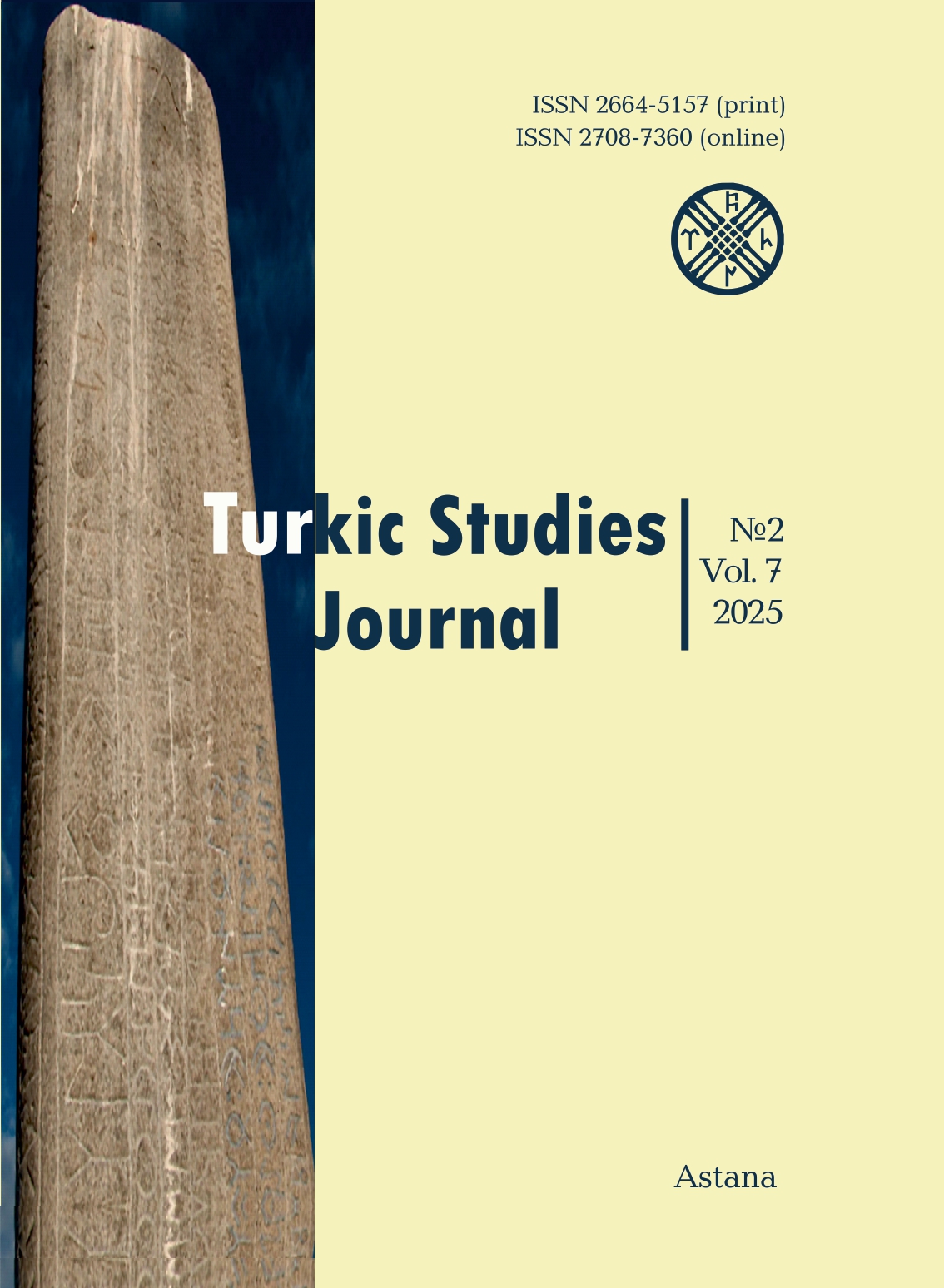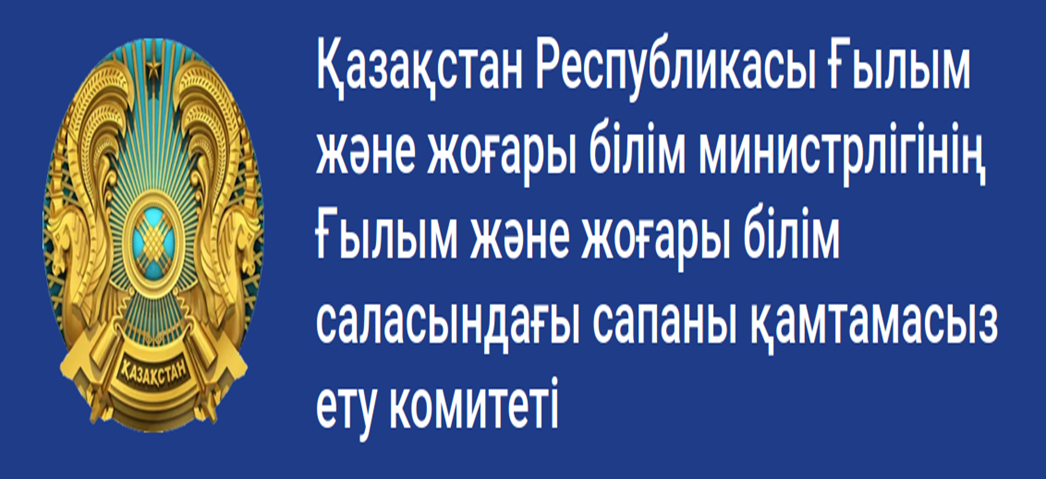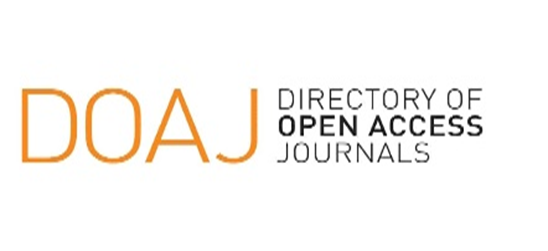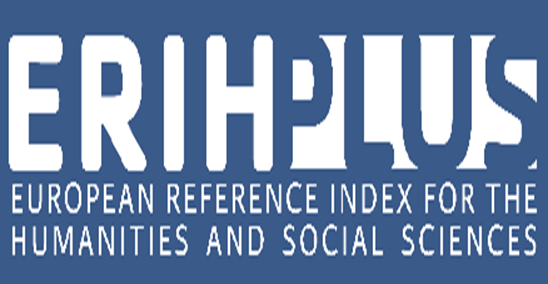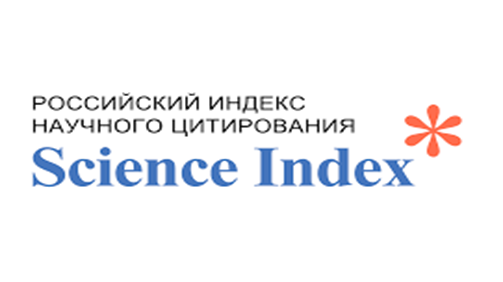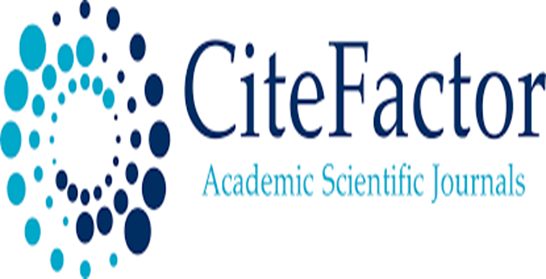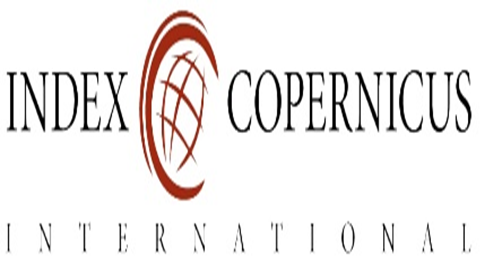Sh. Marjani’s Contribution to the Historiography of the Qarakhanid State
Views: 226 / PDF downloads: 128
DOI:
https://doi.org/10.32523/2664-5157-2025-2-86-105Keywords:
Qarakhanid dynasty (or state), Shigabutdin Marjani, “Gurfat al-Khawākin li Arfāt al-Khawākin”, medieval sources, numismatic artifacts, ulemas, source studies, Transoxiana, Satuk Bughra Khan, “Ghilālat al-Zamān fī Tārīkh Bulghār wa-Qazān”.Abstract
At present, numerous studies focus on the history of the Turkic-Muslim dynasty known in historical scholarship as the Qarakhanid state, which played a major role in the
political and cultural development of medieval Central Asia between the 10th and 12th centuries. Although the first academic works on the Qarakhanids appeared in the West as early as the 18th century, the absence of key medieval Arabic sources left many of these studies incomplete, often limiting them to tracing the dynasty’s origins. The state’s political history and the evolution of its religious ideology remained largely unexamined. Even material culture, such as Qarakhanid coinage studied by Russian imperial numismatists in the early 19th century, received limited scholarly attention.
In studies on the rulers and history of the Qarakhanid state, the works of Ch.M. Fraehn, Ch.Ch. Valikhanov, V.V.Grigoriev, and V.V. Bartold have been widely cited. However, for a long time, the contribution of the prominent 19th-century Tatar historian, educator, and thinker Shigabutdin Marjani remained largely overlooked. In his treatise Gurfat al-Khawākin li Arfāt al-Khawākin, Marjani examined the history of the Qarakhanid state, offering valuable insights into the political landscape of Central Asia in the 10th-12th centuries. Despite its brevity, just 33 pages, the work contains a wealth of information about the region and the
functioning of the Qarakhanid state. It should be noted that Shigabutdin Marjani’s work fell into obscurity, one of the reasons often cited is the publication of V.V. Bartold’s book Turkestan Down to the Mongol Invasion, and only relatively recently have the ideas of the Tatar historian begun to enter academic discourse. The authors of the article also examine the works of Western scholars devoted to the history of the Qarakhanid state, such as Joseph de Guignes, Сh.M Fraehn, K.J. Tornberg and others, carrying out their critical analysis. Highlighting the relevance and value of Gurfat al-Khawākin li Arfāt al-Khawākin by Sh. Marjani, the authors of the article argue that Marjani’s work fills numerous gaps in the study of the medieval Qarakhanid state, and that his contribution is an undeniable asset to its historiography.
Downloads
Reference
Бартольд В.В., 1963. Туркестан в эпоху монгольского нашествия. Том І. Москва: Издательство Восточной литературы. 760 с.
Валиханов Ч.Ч., 1985а. Собрание сочинений в пяти томах. Том 3. Алма-Ата. Главная редакция Казахской советской энциклопедии. 416 с.
Валиханов Ч.Ч., 1985б. Собрание сочинений в пяти томах. Том 4. Алма-Ата. Главная редакция Казахской советской энциклопедии. 461 с.
Верность предшественникам и приветствие потомкам: Перевод с арабского избранных биографий, исследование, комментарии, факсимиле разделов о ВолгоУральском регионе, 2022. Казань: Магариф-Вакыт. 856 с.
Григорьев В.В., 1863. Неизданные монеты уйгурских владельцев Мавераннагра. Ученые записки Казанского университета. Казань: Типография Университета. С. 1-14.
Григорьев В.В., 1873. Восточный или Китайский Туркестан. СПб. 580 с.
Григорьев В.В., 1883. Караханиды в Мавераннагре по Тарихи Мунедджим Баши. Туркестанский сборник сочинений и статей, относящихся до Средней Азии вообще и Туркестанского края в особенности. СПб. С. 1-70.
Газиз Г., 2001. Мәржанинең голум (гыйлемнәр), фәнун (фәннәр) вә санаигька (сәнгать – һәнәрләргә) карашы. Мәржани. 2001. С. 122-153.
Извлечение вестей о состоянии Казани и Булгара (Мустафад ал-ахбар фи ахвали Казан ва Булгар), 2005. Часть І. Казань: Издательство «ФЭН» АН РТ. 255 с.
Кочнев Б.Д., 2006. Нумизматическая история Караханидского каганата (991-1209 гг.). Часть І. Источниковедческое исследование. Москва: Еуразия. 314 с.
Марджани Ш., 1884. Гилалат аз-заман фи-тарихи Булгар уа Казан. Труды Четвертого Археологического съезда в России, бывшего в Казани с 31 июля по 18 августа 1877 года. Казань: Типография Императорского Университета. 652 с.
Махаева А.Ш., Әлімжанов Е.А., 2020. Маржани – тағлымы мол тарихшы. Абай атындағы ҚазҰПУ. Хабаршы. №2 (65). 640-644 б.
Мөстәфадел-әхбар фи әхвали Казан вә Болгар (Казан һәм Болгар хәлләре турында файдаланылган хибәрләр), 1989. Кыскартып төзелде., Казан: Татар. кит. нәшр. 415 бит.
Рүстемов С.К., 2024. Тарихтың қоғамдағы орны мен методологиясы мәселелерінің Ш.Маржани еңбектерінде көрініс табуы хақында. Тарихшы-ғалым Сәулебек Керімбекұлы Рүстемов: ғылыми мұрасы. Алматы: «KEMEL-KITAP» баспасы. 331-340 б.
Салихов А.Г., 2001. Научная деятельность А.Валидова в России. Уфа: Гилем. 164 с.
Тарихи Муллозода дар Зикри Мазороти Бухоро. Форс тилидан таржима, муқаддима, тадқиқ, изоҳлар, иловалар муаллифи ва нашрга тайёрловчи: Комилжон Раҳимов. Ташкент: «Фан» нашриёти. 216 б.
Тимохин Д.М., 2021. Упоминания титулатуры тюркских правителей при описании истории Газневидов в «Таба’и’ ал-Хаййаван» ал-Марвази. Российско-азиатский правовой журнал. №3. С. 60-65.
Юсупов М.Х., 1981. Шигабутдин Марджани как историк. Казань: Татарское книжное издательство. 233 с.
Biran, M., 2005. The Empire of the Qara Khitai in Eurasian History: Between China and the Islamic World. Cambridge: Cambridge University Press. 279 p.
Guignes J.de., 2018. Hunların, Türklerin, Moğolların ve daha saır batı tatarlarının Tarih-i Umumisi. Cilt I. İstanbul: Ötüken. 719 s.
Guignes J.de., 2018. Hunların, Türklerin, Moğolların ve daha saır batı tatarlarının Tarih-i Umumisi. Cilt II. İstanbul: Ötüken. 760 s.
Guignes J.de., 2018. Hunların, Türklerin, Moğolların ve daha saır batı tatarlarının Tarih-i Umumisi. Cilt III. İstanbul: Ötüken. 768 s.
Fraehn Ch.M., 1826. Numi Muhammedani, qui in Academiae Imperialis Scientiarum Petropolitanae Museo Asiatico Asservantur, Vol. 1. Petropoli: Litteris Academicis. 743 p.
Hunkan Ö.S. 2010. Türk Hakanlığı (Karahanlılar)'nda Hanedan ve Bürokrat-Ülema çatışması: ilk bürokrat-ulema ihtilali. XV. Türk Tarih Kongresi. Cilt 3. 2010. s. 653-66.
Hunkan Ö.S. 2016. Türk Hakanlığı (Karahanlılar)'nın Dinî Siyaseti'nde Mâturîdî Âlimlerin Rolü. Trakya Üniversitesi Sosyal Bilimler Dergisi. Cilt 18 (Sayı 2). s. 377-393.
Hunkan Ö.S., 2020. Kazanlı Türk Bilgini Şehabeddin Mercani ve Gurfetü’l-Hevakin li Urfeti’l-Havakin’e göre Satuk Buğra han ve oğulları (921-1212). İstanbul: Bilge. 136 s.
Ibn Khallikan's Biographical Dictionary, 1843. Translated from the Arabic be Mac Guskin de Slane. Volume I. 688 p.
Ibn Khallikan's Biographical Dictionary, 1868. Translated from the Arabic be Mac Guskin de Slane. Volume III. 699 p.
Kitab-I Yamini, 1858. Historical memoirs of the Amir Sabaktagin, and the Sultan Mahmud of Ghazna. London: The Oriental Translation Fund of Great Britain and Ireland. 511 p.
Klaproth J.H., 1826. Tableaux historiques de L’Asie. Paris, Schubart. 289 p.
Müstefadü’l-Ahbar fi ahval-i Kazan ve Bulgar, 2008. Ankara: Atatürk Kültür Merkezi. 347 s.
Pritsak O., 1997. Karahanlılar. İslam Ansiklopedisi, Cilt VI. İstanbul: Milli Eğitim Bakanlığı Yayınları. 251-273 s.
Sharaf al-Zaman Tahir Marvazi on China, the Turcs and India, 1942. London: The Royal Asiatic society. 112 p.
Shaw R.B., 1878. A sketch of the Turkic Language as spoken in Eastern Turkistan. Calcutta: Printed be C.B. Lewis. 109 p.
Tornberg С.J., 1848. Numi cufici Regii numophylacii holmiensis, quos omnes in terra sueciae repertos. Upsaliae: Excudesant Leffler ed Sksell. 315 p.
REFERENCE
Bartold V.V., 1963. Turkestan v epohu mongolskogo nashestvia [Turkestan Down to the Mongol Invasion]. Tom I. Moskva: İzdatelstvo Vostochnoi literatury. 760 p. [in Russian]
Valihanov Ch.Ch., 1985a. Sobranie sochineni v pyati tomah [Collected Works in Five Volumes]. Tom 3. Alma-Ata. Glavnaia redaksia Kazahskoi sovetskoi ensiklopedii. 416 p. [in Russian]
Valihanov Ch.Ch., 1985b. Sobranie sochineni v pyati tomah [Collected Works in Five Volumes]. Tom 4. Alma-Ata. Glavnaia redaksia Kazahskoi sovetskoi ensiklopedii. 461 p. [in Russian]
Vernost’ predshestvennikam I privetstviye potomkam: Perevod s arabskogo izbrannyh biografii, issledovanie, kommentarii, facsimile razdelov o Volgo-Ural’skom regione [Loyalty to predecessors and greetings to descendants: Translation from Arabic of selected biographies, research, commentary, facsimile of sections on the Volga-Ural region], 2022. Kazan: Magarif-Vakyt. 856 p. [In Russian].
Grigoriev V.V., 1863. Neizdannye monety uigurskih vladel’cev Maverannahra [Unissued coins of the Uyghur rulers of Maverannahr], Uchenye zapisi Kazankskogo universiteta [Scientific notes of Kazan University]. Kazan: Tipografiya Universiteta. P. 1-14. [in Russian].
Grigoriev V.V., 1873. Vostochniy ili Kitayskyi Turkestan [Eastern or Chinese Turkestan]. SPb. 580 p. [in Russian].
Grigoriev V.V., 1883. Karahanidy v Maverannahre po Tarihi Muneddjim Bashi [Qarakhanids in Maverannahr by Tarihi Munejjim Bashi]. Turkestanskiy sbornik sochinenii i statey otnosyashihsiya do Sredney Azii voobshe i Turkestanskogo kraya v sobstvennosti [Turkestan collection of works and articles related to Central Asia in general and the Turkestan region in particular]. SPb. P. 1-70. [in Russian].
Gaziz G., 2001. Mardjaninen golum (gyilemnar), fanun (fannar) va sanaigka (sangat-hanarlarga) karashy [Mardjani's views on knowledge, science and art]. Mardjani. 2001. P. 122-153. [in Tatar].
Izvlecheniya vestey o sostoyanii Kazani i Bulgara (Mustafad al-ahbar fi ahvali Kazan va Bulgar) [Extraction of news about the state of Kazan and Bulgar], 2005. Chast’ I., Kazank: Izdatelstvo «FEN» AN RT. 255 p. [in Russian].
Kochnev B.D., 2006. Numizmaticheskaya istoria Karahanidskogo kaganata (991-1209 gg.). Chast I. Istochnikovedcheskoe issledovanie. [Numismatic history of the Qarakhanid Khaganate (991-1209). Part I. Source study]. Moskva: Еvrazia. 314 p. [in Russian].
Mardjani Sh., 1884. Gilalat az-zaman fi-tarihi Bulgar va Kazan [The veil of time covering the history of Bolgar and Kazan]. Trudy Chetvertogo Arheologicheskogo s’ezda v Rossii, byvshego v Kazani s 31 yiula po 18 avgusta 1877 goda. Kazan: Tipografia Imperatorskogo Universiteta [Proceedings of the Fourth Archaeological Congress in Russia, held in Kazan from July 31 to August 18, 1877]. 652 p. [in Russian].
Mahayeva A.Sh., Alimzhanov E.A., 2020. Mardjani – taglimi mol tarihshi [Mardjani – distinguished historian]. Abay atindagy KazUPU. Habarshi [KazNPU named after Abai. Bulletin]. No2 (65). P. 640-644. [in Kazakh].
Mostafadel-ahbar fi ahvali Kazan va Bolgar (Kazan va Bolgar hallare turynda faydalanylgan hibarlar). Kyskartyp tozelde. [Extraction of news about the state of Kazan and Bulgar. In abbreviated form], 1989. Kazan: Tatar.kit.nashr. 415 p. [in Tatar].
Rustemov S.K., 2024. Tarihtyn kogamdagy orny men metodologiyasy maselelerinin Sh.Mardjani enbekterinde korinis tabuy hakynda [On the reflection of the issues of the role and methodology of history in society in the works of Sh. Marjani]. Tarihshi-galim Saulebek Kerimbekuly Rustemov: gylimi murasy [Historian-scientist Saulebek Kerimbekuly Rustemov: scientific heritage]. Almaty: «KEMEL-KITAP» baspasy. P. 331-340. [in Kazakh].
Salihov A.G., 2001. Nauchnaya deyatelnost’ A.Validova v Rossii [Scientific activity of A. Validov in Russia]. Ufa: Gilem. 164 p. [in Russian].
Tarihi Mullozoda dar Zikri Mazoroti Buhoro [Mullazode's historical book about the tombs of Bukhara], 2019. Fors tilidan tarjima, muqaddima, tadqiq, izoҳlar, ilovalar muallifi va naşrga taiörlovchi: Komiljon Raҳimov. Tashkent: «Fan» nashrieti. 216 p. [in Uzbek].
Timohin D.M., 2021. Upominaniya titulatury turkskih pravitelei pri opisanii istorii Gaznevidov v “Taba’i’ al-Hayyavan” al Marvazi. Rossiysko-aziatskiy pravovoy jurnal [References to the title of the Turkic rulers when describing the history of the Ghaznavids in “Taba’l’al-Hayyawan’’ by al-Marvazi]. Rossiisko aziatskii pravovoi jurnal [Russian-Asian Law Journal]. No3. P. 60-65. [in Russian].
Yusupov M.H., 1981. Shigabutdin Mardjani kak istorik [Shigabutdin Mardjani as a historian]. Kazan: Tatarskoe knizhnoe izdatelstvo. 233 p. [in Russian].
Biran, M., 2005. The Empire of the Qara Khitai in Eurasian History: Between China and the Islamic World. Cambridge: Cambridge University Press. 279 p.
Guignes J.de., 2018. Hunların, Türklerin, Moğolların ve daha saır batı tatarlarının Tarih-i Umumisi [General history of the Huns, Turks, Mongols, and other Western Tartars]. Volume I. İstanbul: Ötüken. 719 р. [in Turkish].
Guignes J.de., 2018. Hunların, Türklerin, Moğolların ve daha saır batı tatarlarının Tarih-i Umumisi. [General history of the Huns, Turks, Mongols, and other Western Tartars]. Volume II. İstanbul: Ötüken. 760 р. [in Turkish].
Guignes J.de., 2018. Hunların, Türklerin, Moğolların ve daha saır batı tatarlarının Tarih-i Umumisi. [General history of the Huns, Turks, Mongols, and other Western Tartars]. Volume III. İstanbul: Ötüken. 768 р. [in Turkish].
Fraehn Ch.M., 1826. Numi Muhammedani, qui in Academiae Imperialis Scientiarum Petropolitanae Museo Asiatico Asservantur [Muhammedan Numis, which are preserved in the Asiatic Museum of the Imperial Academy of Sciences of Petropoli], Vol. 1. Petropoli: Litteris Academicis. 743 p. [in Latin].
Hunkan Ö.S., 2010. Türk Hakanlığı (Karahanlılar)'nda Hanedan ve Bürokrat-Ülema çatışması: ilk bürokrat-ulema ihtilali [The Dynasty and the Bureaucrat-Ulema Conflict in the Turkic Khaganate (Karakhanids): The First Bureaucrat-Ulema Revolution]. XV. Türk Tarih Kongresi [XV. Turkish History Congress]. Cilt 3. P. 653-66. [in Turkish].
Hunkan Ö.S., 2016. Türk Hakanlığı (Karahanlılar)'nın Dinî Siyaseti'nde Mâturîdî Âlimlerin Rolü [The Role of Maturidi Scholars in the Religious Policy of the Turkic Khaganate (Karakhanids)]. Trakya Üniversitesi Sosyal Bilimler Dergisi [Trakya University Journal of Social Sciences]. Cilt 18 (Sayı 2). рр. 377-393. [in Turkish].
Hunkan Ö.S., 2020. Kazanlı Türk Bilgini Şehabeddin Mercani ve Gurfetü’l-Hevakin li Urfeti’l-Havakin’e göre Satuk Buğra han ve oğulları (921-1212) [Satuk Buğra Khan and his sons according to Kazan Turkish Scholar Şehabeddin Mercani and Gurfetü’l-Hevakin li Urfeti’l-Havakin (921-1212)]. İstanbul: Bilge. 136 р. [in Turkish].
Ibn Khallikan's Biographical Dictionary, 1843. Translated from the Arabic be Mac Guskin de Slane. Volume I. 688 p.Ibn Khallikan's Biographical Dictionary, 1868. Translated from the Arabic be Mac Guskin de Slane. Volume III. 699 p.
Kitab-I Yamini, 1858. Historical memoirs of the Amir Sabaktagin, and the Sultan Mahmud of Ghazna., London: The Oriental Translation Fund of Great Britain and Ireland. 511 p.Klaproth J.H., 1826. Tableaux historiques de L’Asie [Historical paintings of Asia]. Paris, Schubart. 289 p. [in French].
Müstefadü’l-Ahbar fi ahval-i Kazan ve Bulgar [Extraction of news about the state of Kazan and Bulgar], 2008. Ankara: Atatürk Kültür Merkezi. 347 р. [in Turkish].
Pritsak O., 1997. Karahanlılar [Qarakhanids] // İslam Ansiklopedisi [The Encyclopedia of Islam], Cilt VI. İstanbul: Milli Eğitim Bakanlığı Yayınları. 251-273 р. [in Turkish].
Sharaf al-Zaman Tahir Marvazi on China, the Turcs and India, 1942. London: The Royal Asiatic society. 112 p.
Shaw R.B., 1878. A sketch of the Turkic Language as spoken in Eastern Turkistan. Calcutta: Printed be C.B. Lewis. 109 p.
Tornberg С.J., 1848. Numi cufici Regii numophylacii holmiensis, quos omnes in terra sueciae repertos [To the royal treasury of Holm, all of whom were found in the land of Sweden]. Upsaliae: Excudesant Leffler ed Sksell. 315 p. [in Latin].
Downloads
Published
How to Cite
Issue
Section
License
Copyright (c) 2025 Turkic Studies Journal

This work is licensed under a Creative Commons Attribution-NonCommercial 4.0 International License.

